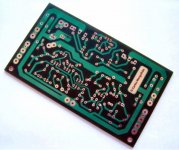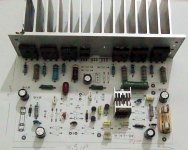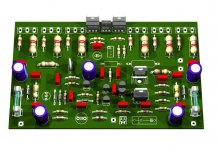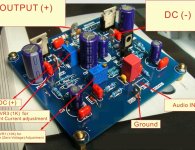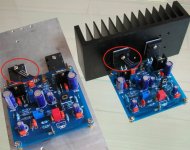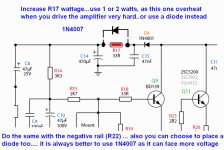Thank you...but go and return...you are welcome here
Just to organize things.
regards,
Carlos
Just to organize things.
regards,
Carlos
can u give characteristic this amp like slew rate, damping factor, THD , TIM , and frequency response?
Sadly there are pirates in Brasil
But gladly they are spreadimd the nice amplifier world wide too.... and this is not that bad.
What is impressive is the small price.....i tried a lot but could never had so low price to boards....this smuggler maybe have ordered thousand boards to obtain such low price.
The board is awfull....aaagh!.... ridiculous layout....and Virtua can have twoi meanings; virtue and virtual....for sure there's no virtue in such kind of illegal , non supported and non authorized behavior
regards,
Carlos
But gladly they are spreadimd the nice amplifier world wide too.... and this is not that bad.
What is impressive is the small price.....i tried a lot but could never had so low price to boards....this smuggler maybe have ordered thousand boards to obtain such low price.
The board is awfull....aaagh!.... ridiculous layout....and Virtua can have twoi meanings; virtue and virtual....for sure there's no virtue in such kind of illegal , non supported and non authorized behavior
regards,
Carlos
Attachments
Last edited:
Hello Carlos
Looking at the silk screen side photo, it seem to me that those pirated Dx Blame board made for the pirate are not fiberglass pcb but just cheap rosin pcb, so they cost less to made and the pirate can sell them for cheap.
So it's a real el-cheapo crap pcb from that pirate, he stoll it to you and he sell a bad copy pcb of your amp.
Bye
Gaetan
Looking at the silk screen side photo, it seem to me that those pirated Dx Blame board made for the pirate are not fiberglass pcb but just cheap rosin pcb, so they cost less to made and the pirate can sell them for cheap.
So it's a real el-cheapo crap pcb from that pirate, he stoll it to you and he sell a bad copy pcb of your amp.
Bye
Gaetan
Last edited:
Yes dear Gaetan...also they are very small...and silk screen seems poor
there's a silk screen that washing boards with Kerozene (aviation fuel) or alcohol, the paint is diluted and removed...maybe this is the case....but interesting anyway, is the low price the one could have.
I have asked Mitchell to search for low price anywhere and he could not find a manufacturer to ask for low price alike this one...maybe the guy have ordered a few thousands boards.
Well....he will sell them all for sure.
These guys could ask me...i would let them go ahead..would ask them a couple of boards (also to test and be sure they're not making any mess with my beloved power amplifier) and they could be free...but people prefer to do this way...bad education...lack of decence i think.... ethics problem.
I do not make living from these things..audio is passion, is hobby to me, not a profession, i give up to work as professional, as when i said that i have lost a lot of friends..and this does not worth the money i can earn doing these things... too much work to assemble and payment is not that good.
regards,
Carlos
there's a silk screen that washing boards with Kerozene (aviation fuel) or alcohol, the paint is diluted and removed...maybe this is the case....but interesting anyway, is the low price the one could have.
I have asked Mitchell to search for low price anywhere and he could not find a manufacturer to ask for low price alike this one...maybe the guy have ordered a few thousands boards.
Well....he will sell them all for sure.
These guys could ask me...i would let them go ahead..would ask them a couple of boards (also to test and be sure they're not making any mess with my beloved power amplifier) and they could be free...but people prefer to do this way...bad education...lack of decence i think.... ethics problem.
I do not make living from these things..audio is passion, is hobby to me, not a profession, i give up to work as professional, as when i said that i have lost a lot of friends..and this does not worth the money i can earn doing these things... too much work to assemble and payment is not that good.
regards,
Carlos
I am preparing a new board, dear Gaetan, in another place...not at my home
is beeing made in another world forum.
This one will be special and cost will be very low.... pirates will not have the chance to even compete with these board's quality and features.
Let it be.... in the reality...spreading my amplifier and my name wide world.
That guy, the pirate, said he has only few boards... i gonne there and asked 1000 boards..to pay using bank sent money...i have made to test the guy.... he said can provide...so...you see it is not only a few boards he have as he said..... he said he have few boards...this is only to scape to make agreements with uncle charlie.
hehehehe...people think is more clever than others...we all have the same brain over the neck, inside the skull...it is stupid to think that others are stupid.
regards,
Carlos
is beeing made in another world forum.
This one will be special and cost will be very low.... pirates will not have the chance to even compete with these board's quality and features.
Let it be.... in the reality...spreading my amplifier and my name wide world.
That guy, the pirate, said he has only few boards... i gonne there and asked 1000 boards..to pay using bank sent money...i have made to test the guy.... he said can provide...so...you see it is not only a few boards he have as he said..... he said he have few boards...this is only to scape to make agreements with uncle charlie.
hehehehe...people think is more clever than others...we all have the same brain over the neck, inside the skull...it is stupid to think that others are stupid.
regards,
Carlos
Attachments
Hello Carlos
I found a web page where they copy all popular amps, the Dx, the Pass Lab, the Quad, the Naim, etc... that is ripp-off and piracy on big scale.
All those pirates do surf all the diy amps forums on the web, and they look for the most popular amps and schematics, they don't know a lot about amp design, but they don't mind since they pirate other's amps designs.
Bye
Gaetan
I found a web page where they copy all popular amps, the Dx, the Pass Lab, the Quad, the Naim, etc... that is ripp-off and piracy on big scale.
All those pirates do surf all the diy amps forums on the web, and they look for the most popular amps and schematics, they don't know a lot about amp design, but they don't mind since they pirate other's amps designs.
Bye
Gaetan
Last edited:
A couple of quick questions (for Carlos):
Is there a reason why 47nF was chosen for the poly decoupling caps instead of the usual 100nF?
Why is the Zobel 15R + 47nF instead of the more usual 10R + 100nF?
Thanks.
Is there a reason why 47nF was chosen for the poly decoupling caps instead of the usual 100nF?
Why is the Zobel 15R + 47nF instead of the more usual 10R + 100nF?
Thanks.
Decoupling caps can go from 103 to 224
The reason why was that i had them at my home..huge ones to high voltage...as i use to make prototype..when finished i copy the values used in the prototype board to the final schematic...this way these values became standard..no problem to use the most common values.... 100N and 10 ohms..well..these parts will not operate anyway in my amplifiers..you can even remove them..... Dx Blame is very stable.
These decoupling ones cannot be coiled internally...so, not beeing coil internally you can use the value you have with twice the rail voltage... as almost all values higher than 10N will be good, as they will represent a very low resistance to drain oscilations as soon as they start... when the electrolitic condensers, because coiled (inductors) are a resistance to high frequencies cross them in direction to the ground.
regards,
Carlos
The reason why was that i had them at my home..huge ones to high voltage...as i use to make prototype..when finished i copy the values used in the prototype board to the final schematic...this way these values became standard..no problem to use the most common values.... 100N and 10 ohms..well..these parts will not operate anyway in my amplifiers..you can even remove them..... Dx Blame is very stable.
These decoupling ones cannot be coiled internally...so, not beeing coil internally you can use the value you have with twice the rail voltage... as almost all values higher than 10N will be good, as they will represent a very low resistance to drain oscilations as soon as they start... when the electrolitic condensers, because coiled (inductors) are a resistance to high frequencies cross them in direction to the ground.
regards,
Carlos
Last edited:
I perceive R17 hot while i was pushing the amplifier very hard
Playing full power a pipe organ...huge bass and i felt the resistance start to smell....so.... a good idea is to increase it's watts ratio, and this was already made in Brazilian boards.... also you can put 1N4007 diode in the resistance place substituting it by the diode.... try 1 or 2 watts..the bigger one you find room to install there.
Also, as i have told you before, several times, it is a good idea to install big transistors in the Q6 position.... so, the two VAS uses bigger transistors, not the small 2N5551 or BC546 anymore...this was done in the earlier models and boards....also a good idea to use heatsinks on them (both) if your amplifier is MKII Supercharged, MKII and MKIII.
regards,
Carlos
Playing full power a pipe organ...huge bass and i felt the resistance start to smell....so.... a good idea is to increase it's watts ratio, and this was already made in Brazilian boards.... also you can put 1N4007 diode in the resistance place substituting it by the diode.... try 1 or 2 watts..the bigger one you find room to install there.
Also, as i have told you before, several times, it is a good idea to install big transistors in the Q6 position.... so, the two VAS uses bigger transistors, not the small 2N5551 or BC546 anymore...this was done in the earlier models and boards....also a good idea to use heatsinks on them (both) if your amplifier is MKII Supercharged, MKII and MKIII.
regards,
Carlos
Attachments
Single diodes... as shown here :
An externally hosted image should be here but it was not working when we last tested it.
link: Analog Devices : Analog Dialogue : Input Protection
This will limit the input to +/- .8V (1.6v p-p)
For our "super amps" , to have a good amount of headroom , double (2 pairs in series) "back to back" diodes to get 3.2V p-p input limit. Good "fix" for those who "nuke" thier amps with preamps on steriods (10v p-p OP)
OS
Under normal conditions (under 3.2v p-p) the diodes would never clip and would offer a stiff upper limit to the input. AGC is known to me (basically a compressor).
Here is that circuit you mentioned (pix-below 1) link: http://www.arrl.org/files/file/QEX_Next_Issue/Sep-Oct_2010/Anderson%20Sept-Oct.pdf
This would be better put at the output of the preamp , one must note that either clipping or compression DOES alter the signal . Clipping sets a "hard limit" , but compression (AGC) might affect the sound otherwise. 🙁
OS
Interesting and IMO, a good pre-amp improves the sound over passive all the time, PC or laptops are devoid of such quality, even with upgraded soundcard.
question , what is the input impedance of the "X" >
Regards,
Thank you Ostripper.... these diodes where used by Hugh Dean
several years ago...i do think he picked broadcasting...this detects radio frequency too..but we can place capacitors and inductors to block..so...the idea is very good Ostripper....i will include it in the MAKO and will test it.
Input impedance to the Dx Blame ES and ST is 10K....Dx Blame MKII (low impedance output one) and Dx Blame MKII Supercharged (operating 55V) use 47K as input impedance.
Take a fast look at the schematic and just watching you will have this answers Ostry.
Schematic are here:
http://users.tpg.com.au/users/gerskine/dxamp/
And here:
http://www.dx.kinghost.net/
regards,
Carlos
several years ago...i do think he picked broadcasting...this detects radio frequency too..but we can place capacitors and inductors to block..so...the idea is very good Ostripper....i will include it in the MAKO and will test it.
Input impedance to the Dx Blame ES and ST is 10K....Dx Blame MKII (low impedance output one) and Dx Blame MKII Supercharged (operating 55V) use 47K as input impedance.
Take a fast look at the schematic and just watching you will have this answers Ostry.
Schematic are here:
http://users.tpg.com.au/users/gerskine/dxamp/
And here:
http://www.dx.kinghost.net/
regards,
Carlos
Last edited:
something wrong here.i felt the resistance start to smell....so.... a good idea is to increase it's watts ratio,.... try 1 or 2 watts..the bigger one you find room to install there.
R17 passes <20mA. It feeds the LTP at the input and feeds the VAS.
Power dissipated at quiescent state, assuming 20mA, is ~ 13mW
When the amp is driven the LTP current stays substantially the same. The VAS current varies either side of the quiescent value. The average power dissipation when the VAS is processing the audio signal remains at the Pq value.
The amp is misbehaving if R17 runs warm.
Fitting a higher power resistor will not stop the amp misbehaving.
You have to find out why R17 is passing extra current.
You don't stick an Elastoplast over the cut where a leg is almost severed off.
Are we back to the missing resistor in the collector of the VAS buffer?
I do think my audio source..the audio program, was what has driven my PC amplifier
... into oscilations...my PC amplifier..the one i use together my amplifier sometimes uses other audio sources, as DVD players, CD players, Satelite Receivers, Open Reel decks and so on.....because i have plugged an audio source with non filtered sample frequency (China old DVD player).... i could see the frequency in the scope latter...this have overdrive the unit...not common to face that in daily use...so, i will not protect the amplifier against old China DVDS that have bad filtered oscilators presented in the output signal.
We should give a limit to our obsessive search for reliability against all kinds of misuse..or we gonna turn crazy with concerns, as people can make all kind of strange things with a home amplifier made for music reproduction..a high sonic quality one.
The colector resistance was not included because sonics..i have tried.... no good..also i tried to increase Q6 emitter resistance and had no good results..then i decided to put bigger transistor and more watts to the resistance to face some non standard signals without to mess with audio quality.... well...these are designer decisions..i took mine.
Also, and important too, is that more than 200 kits where sold in DIY foruns wide world and inside group buys with cost price) and no one of these boards have room to install colector resistance in Q6 colector.... this would mess with all boards with people cutting tracks below the board to install series resistances..a very dirty work.... i decided to avoid mess and also losses in audio quality, to prepare the amplifier to face overloads changing Q6 for a higher power dissipation unit, able to face more current and also increasing the rail resistances that may overheat if the amplifier is driven very hard.
And happened.... one used a Bass guitar...and have injected high level in the power amplifier input...and the amplifier was not made to bass guitar...this drives the amplifier very hard with continuous tones...to use as a guitar, this amplifier needs to have several extra pairs in the output to face the heavy duty job.... and this same guy came to me to ask why his amplifier heatsinks had more than 60 degrees in the heatsink...funny that.
Another one plugged a 8 volts RMS output preamplifier and turned the volume all the way up..ahahahahaha.....alike to disengage a motor and make it turn full throotle.... engine will self destroy because bad lubrication while in very high speed (rpm)..... and this happened after i explained and posted several times, also using videos, foruns published texts and emails, that people should avoid preamplifiers..that they are not needed as the amplifier can be adjusted to receive all kind of input signal levels...but even this way someone made that...i cannot avoid some exotic guys doing such kind of things..or i will have to produce a very protected amplifier, with tenths of output transistors and with bad sonics because over voltage, over current, over saturation, anti clipping and a lot of sonic killing sub circuits...not way to me to destroy sonics this way.
Another one made the mistake to inject square waves, high frequencies, form a 2 volts rms output audio generator...when the amplifier was made to 750 milivolts PEAK!...i had three cases in more than 200 guys...this is 1.5 percent only...anything to worry too much.
we cannot be too much obsessive protecting amplifiers against all kind of foolishes people can make with them...to make shorts into the output while the amplifier will be pumping out full power.... we cannot avoid women to put some clothing over the heatsink grilles we have at the amplifier top ...holes to allow hot air to go out from the internal heatsinks (when internal)...we cannot avoid someone to drop a can o beer inside the enclosure and we cannot shield the unit to avoid someone to run down or pass over with a war tank.
Amplifiers to be cheap, have always some weak points.... we have also to trust people will use them for the purposes they where made...in this case to work with music, home music and not a professional heavy duty application, using the correct input level and output impedance... and not bad use alike to use it under the rain or sunlight or other kind of foolishes people can make
Your suggestion, Andrew T, was good, as would make the amplifier huge..but not good to apply now a days....these things should be implemented when we design the amplifier...sadly we had not good communications when the design was in the early moments... the early begining... reason why some of our ideas where not used...in this case, i have tried...no good audio result...this colector resistance would not be used anyway.
regards,
Carlos
... into oscilations...my PC amplifier..the one i use together my amplifier sometimes uses other audio sources, as DVD players, CD players, Satelite Receivers, Open Reel decks and so on.....because i have plugged an audio source with non filtered sample frequency (China old DVD player).... i could see the frequency in the scope latter...this have overdrive the unit...not common to face that in daily use...so, i will not protect the amplifier against old China DVDS that have bad filtered oscilators presented in the output signal.
We should give a limit to our obsessive search for reliability against all kinds of misuse..or we gonna turn crazy with concerns, as people can make all kind of strange things with a home amplifier made for music reproduction..a high sonic quality one.
The colector resistance was not included because sonics..i have tried.... no good..also i tried to increase Q6 emitter resistance and had no good results..then i decided to put bigger transistor and more watts to the resistance to face some non standard signals without to mess with audio quality.... well...these are designer decisions..i took mine.
Also, and important too, is that more than 200 kits where sold in DIY foruns wide world and inside group buys with cost price) and no one of these boards have room to install colector resistance in Q6 colector.... this would mess with all boards with people cutting tracks below the board to install series resistances..a very dirty work.... i decided to avoid mess and also losses in audio quality, to prepare the amplifier to face overloads changing Q6 for a higher power dissipation unit, able to face more current and also increasing the rail resistances that may overheat if the amplifier is driven very hard.
And happened.... one used a Bass guitar...and have injected high level in the power amplifier input...and the amplifier was not made to bass guitar...this drives the amplifier very hard with continuous tones...to use as a guitar, this amplifier needs to have several extra pairs in the output to face the heavy duty job.... and this same guy came to me to ask why his amplifier heatsinks had more than 60 degrees in the heatsink...funny that.
Another one plugged a 8 volts RMS output preamplifier and turned the volume all the way up..ahahahahaha.....alike to disengage a motor and make it turn full throotle.... engine will self destroy because bad lubrication while in very high speed (rpm)..... and this happened after i explained and posted several times, also using videos, foruns published texts and emails, that people should avoid preamplifiers..that they are not needed as the amplifier can be adjusted to receive all kind of input signal levels...but even this way someone made that...i cannot avoid some exotic guys doing such kind of things..or i will have to produce a very protected amplifier, with tenths of output transistors and with bad sonics because over voltage, over current, over saturation, anti clipping and a lot of sonic killing sub circuits...not way to me to destroy sonics this way.
Another one made the mistake to inject square waves, high frequencies, form a 2 volts rms output audio generator...when the amplifier was made to 750 milivolts PEAK!...i had three cases in more than 200 guys...this is 1.5 percent only...anything to worry too much.
we cannot be too much obsessive protecting amplifiers against all kind of foolishes people can make with them...to make shorts into the output while the amplifier will be pumping out full power.... we cannot avoid women to put some clothing over the heatsink grilles we have at the amplifier top ...holes to allow hot air to go out from the internal heatsinks (when internal)...we cannot avoid someone to drop a can o beer inside the enclosure and we cannot shield the unit to avoid someone to run down or pass over with a war tank.
Amplifiers to be cheap, have always some weak points.... we have also to trust people will use them for the purposes they where made...in this case to work with music, home music and not a professional heavy duty application, using the correct input level and output impedance... and not bad use alike to use it under the rain or sunlight or other kind of foolishes people can make
Your suggestion, Andrew T, was good, as would make the amplifier huge..but not good to apply now a days....these things should be implemented when we design the amplifier...sadly we had not good communications when the design was in the early moments... the early begining... reason why some of our ideas where not used...in this case, i have tried...no good audio result...this colector resistance would not be used anyway.
regards,
Carlos
Last edited:
I did not turn on the "ignore" option.Your suggestion, Andrew T, was good, as would make the amplifier huge..but not good to apply now a days....these things should be implemented when we design the amplifier...sadly we had not good communications when the design was in the early moments... the early begining... reason why some of our ideas where not used...in this case, i have tried...no good audio result...this colector resistance would not be used
You did turn on the "ignore" option and advertised that fact (repeatedly) that you had closed your ears and mind to all suggestions to improve performance and/or reliability.
It is not too late to incorporate the Q6 collector resistor.
It does not requires any trace cutting.
It does not involve any "back of board" modifications.
You can adopt a low value collector resistor similar to Ost or you can adopt a higher value that I recommend. The choice is the builders, if I/we give them the information on which they can take informed decisions.
Are you willing to listen?
Builders can take this decision Andrew T
So, let them decide if they want to do or not...just inform the value of resistance you suggest and let them do what they believe gonna be better to them...reliability or sonics..their decision.
I will not include this in my design officially, builders can think about and take their own decision about.
All forum guys have brain..all them have intelligence and a lot of them have know how too... some of them have practice...they know you and they know me...they know you are good in calculations and theories and that i am good in practice...so...they can take their decisions... at the end the amplifier belongs to them.
regards,
Carlos
So, let them decide if they want to do or not...just inform the value of resistance you suggest and let them do what they believe gonna be better to them...reliability or sonics..their decision.
I will not include this in my design officially, builders can think about and take their own decision about.
All forum guys have brain..all them have intelligence and a lot of them have know how too... some of them have practice...they know you and they know me...they know you are good in calculations and theories and that i am good in practice...so...they can take their decisions... at the end the amplifier belongs to them.
regards,
Carlos
Last edited:
- Status
- Not open for further replies.
- Home
- Amplifiers
- Solid State
- Dx Blame ST - Builder's thread - post pictures, reviews and comments here please.

